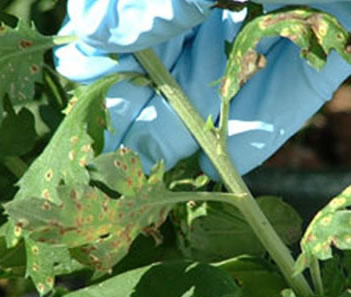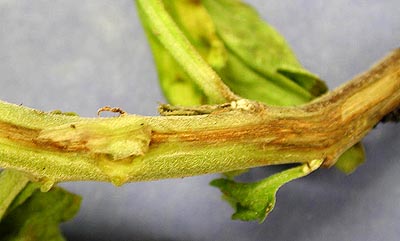Pests
Aphids, thrips, leafminers and mites are the common insects attacking chrysanthemum. Spraying with any recommended insecticides may control the infestation.
Aphids (Macrosiphoniella sanborni):

|
Greenish-black nymphs and chocolate brown adults suck the cell sap from growing shoots and lower surface of leaves. Damage by aphid's results in loss of vigour, yellowing and premature leaf fall and stunted growth of attacked plants. Honey dew secreted by aphids favours development of sooty mould. The pest also acts as a vector of viral diseases. Control : Grubs and adults of Coccinellid beetles prey upon the aphids and effectively wipe out their population. |
Thrips (Frankliniella sp.):
|
Slender, white coloured nymphs and black adults feed on tender leaves causing silvering, mottling and distortion of leaves. Damaged flowers look discoloured, withered and dried due to scorching. Severe infestation adversely affects quality and quantity of flower production. Control : Drenching the soil with good insecticide also helps in reducing the population. |

Leaf Folder (Hedylepta indicata):
It occasionally attains a status of serious pest on chrysanthemum. Pale-white coloured eggs are laid singly or in small groups on lower side of leaves. Green coloured larvae with brown head fold leaves together and feed on chlorophyll. The affected leaves get skeletonized and dry. The larvae also damage flowers.
Control : Cutting and burning infested plant parts reduces pest infestation. Two or three sprays of Quinalphos @0.05% gives effective control of leaf folders.
Bud Borer (Helicoverpa armigera):
Female adult deposits round, cream coloured eggs singly on bracts and petals of buds. Larvae feed on growing flowers resulting in considerable flower loss.
Control: Collection and destruction of damaged buds and flowers reduces further damage. Setting of light traps helps to control adult population by attracting them.
Hairy Caterpillar (Spilosoma obliqua):
Female moth lays eggs in clusters on lower side of leaves. Black coloured matured larvae feed voraciously on leaves and buds and cause severe defoliation.
Control : Collection and destruction of egg masses and leaves infested with early larval instars of hairy caterpillar reduces pest build up. Deep ploughing in summer exposes pupae to predators.
Termites (Microtermes obesi):
Termites mainly feed on roots. In case of severe infestations they spread to stem portion of the bark. Attack by the pest becomes severe under dry soil conditions. Damaged plants wilt, dry and finally die if infestation is very high.
Control : Deep ploughing destroys the termite colonies. Proper irrigation and avoiding dry soil conditions prevents pest build-up. Drenching the soil with Chlorpyriphos @0.05% before planting protects plants from termite attack.
Lesion Nematode (Pratylenchus coffeae):
The nematode causes heavy root damage, which subsequently leads to poor growth of chrysanthemum. The symptoms are in the form of stunting of plants with premature yellowing and drying of leaves, reduced flower size and dark lesions on the roots.
Control : Application of neem cake @ 1ton/ha or Carbofuran @ 2kg/ha reduces the nematode population.
Bud and Leaf Nematode (Aphelenchoides ritzemabosi):
The nematode causes considerable damage to the foliage of chrysanthemum. Interveinal discolouration of leaves and their death is the characteristic symptom.
Control : Hot water treatment of suckers at 46°C for 5 minutes and spraying 0.02% Thionazin on aerial parts is recommended.
Diseases
Cercospora leaf spot, Alternaria leaf spot, Fusarium stem rot and powdery mildew are the common diseases attacking chrysanthemums. Using any fungicide can control these diseases.
Wilt (Fusarium oxysporum f.sp. chrysanthemi):
Initial symptoms are in the form of yellowing and browning of leaves. Affected leaves die from the base of the plant upward. Infected plants are stunted and often fail to produce flower. Wilting may cause rotting of root or the base of the stem.
Control : Since the disease is soil borne it is difficult to control with chemicals alone. Drenching the soil with Dexon or Carbendazim is very effective. Before planting dipping the rooted cuttings in a solution of Thiram @1.5g/litre of water is effective. Since the disease spreads mostly through cuttings, it is important to use disease free planting material. Disease can further be minimised by following strict sanitation; periodical monitoring; crop rotation and rouging of infected plants.
Rust (Puccinia crysanthemi):

|
Rust is a serious disease especially in the early spring. The disease symptoms are in the form of brown blister-like swellings, which appear on the undersides of leaves. These burst open releasing masses of brown, powdery spores. Severely infected plants become very weak and fail to bloom properly. Control : Early removal of infected leaves/plants helps to prevent the further spread of the disease. Spraying the plants with Karathane @0.025% or dusting with Wettable Sulphur @0.2% is effective in controlling the disease. |
Septoria Leaf Spot (Sepotria chrysanthemella):
|
Leaf spots occur during cool-wet periods of the rainy season. Since the pathogens are spread through rain splashes the lowermost leaves get infected first. Serious infection may result in premature withering of the leaves; the dead leaves hang to the stem for some time. When flowering starts the infection occurs on flower buds, which rot completely. Control : This disease can be controlled by spraying carbendazim @0.05% six times at 15 days intervals from the end of July or spraying Benomyl (0.1%) followed by Captafol (0.2%) and Carbendazim (0.1%). Destruction of disease debris and avoiding excessive irrigation is recommended. |

Stem Rot (Fusarium solani):
The disease is noticed in cuttings, stock plants and flowering plants. It is serious during rainy weather. The affected plants show different symptoms such as leaf chlorosis, necrosis, decay and discoloration of internal portion of the stem. When the flower buds are about to open, small dark streaks are seen at the base of the stem. Root decay is noticed only in advanced stages of infection. In many cases the infection is devoid of any external symptoms and roots also look healthy. In some cases stem and root rot are confined to one side of the stem, the other side remaining healthy.
Control : Cuttings should be taken from healthy plants. Following strict field sanitation, rouging of infected plants and crop rotation helps to minimize the disease incidence. Spraying with Carbendazim (0.1%) or Bordeaux mixture (1%) and avoiding excessive moisture in beds help in checking the disease.

Powdery Mildew (Oidium chrysanthemi):
Infection is more severe in older plants under humid conditions. The growth of the fungus on the leaves appears as powdery coating. Infected leaves turn yellow and dry out. Infected plants remains stunted and fail to flower.
Control : Disease can be effectively controlled with Sulphur fungicides or Captan (0.2%). Good ventilation and proper spacing for free circulation of air is recommended.
Source: http://www.ficciagroindia.com/production-guidelines/flowers/Chrysanthemum/diseases.htm
